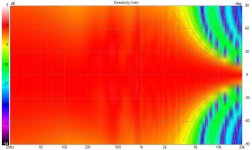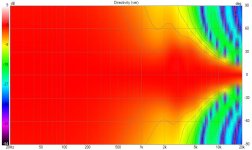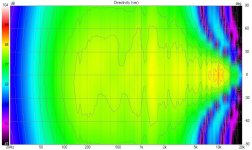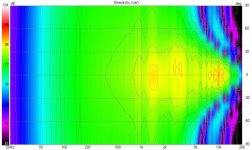... and so black it's barely visible!less wide than the head
reading reviews of rounded baffles, the sound image is better compared to it “sticking” to the baffle…. Think revel salon vs f206.
I find felt around a dome tweeter makes the highs “sharper”, clearer.
But a ball enclosure has a huge internal standing wave internally due to wavelength vs diameter. I think the egg would be best to randomize internal freq pressures….
I like the idea of a tall column. You would still need to address the circular standing wave, but maybe you can use the height to your advantage similar to a mltl……
Think the kef blade for a shape…..
I find felt around a dome tweeter makes the highs “sharper”, clearer.
But a ball enclosure has a huge internal standing wave internally due to wavelength vs diameter. I think the egg would be best to randomize internal freq pressures….
I like the idea of a tall column. You would still need to address the circular standing wave, but maybe you can use the height to your advantage similar to a mltl……
Think the kef blade for a shape…..
You do not hear the wavefront following the baffle because there are no disturbances to make a sound 😉“sticking” to the baffle
Continuation of a correct baffling arrangement doesn't result in diffraction..
Not that all diffraction is unavoidable, and nor does all diffraction have to be a problem.
Narrow baffles are about dumping all the diffraction as soon as possible, counting on mitigating circumstances. Unfortunately it also forgoes controlling directivity.
Not that all diffraction is unavoidable, and nor does all diffraction have to be a problem.
Narrow baffles are about dumping all the diffraction as soon as possible, counting on mitigating circumstances. Unfortunately it also forgoes controlling directivity.
So many image experts? and no instant answer, or even wild guesses?
Surly image experts would instantly be able to tell us?
Surly image experts would instantly be able to tell us?
Everyone can back up their science with so much confidence.
So 1 or 2 it is easy answer.
Since a polar graph instantly identifies it.
So 1 or 2 it is easy answer.
Since a polar graph instantly identifies it.
I'll say the narrower dispersion images better.
I'm no imaging expert, it is last on my requirements of speakers.
I had a single thiel cs2 hooked up by a tv. A couch absorbed the left wall voice from that side. The right wall was the door leaving the apartment. When the speaker was left of the tv, the image was locked dead center of the tv. When the speaker was directly right of the tv, the sound seemed to come 3-4' to the right of the speaker, wild.
So I absolutely know of imaging. Worse even would be stereo.........
I can get you graphs on felt and diffraction ...
https://www.speakerdesign.net/audioXpress/diffraction/diffraction.html
Would felt around a dome tweeter help imaging ? I doubt it, but idk.........
I'm no imaging expert, it is last on my requirements of speakers.
I had a single thiel cs2 hooked up by a tv. A couch absorbed the left wall voice from that side. The right wall was the door leaving the apartment. When the speaker was left of the tv, the image was locked dead center of the tv. When the speaker was directly right of the tv, the sound seemed to come 3-4' to the right of the speaker, wild.
So I absolutely know of imaging. Worse even would be stereo.........
I can get you graphs on felt and diffraction ...
https://www.speakerdesign.net/audioXpress/diffraction/diffraction.html
Would felt around a dome tweeter help imaging ? I doubt it, but idk.........
There was posted measurements somewhere, sometime
Adding felt and foam around a tweeter.
The measurements also included a stepped baffle for time alignment.
Measurements also taking to relief the concern of the stepped midrange/woofer edges sticking out and causing " diffraction"
Anyways the foam around the tweeter reduces small / large peaks in the response.
Has more to do with accuracy.
Likely candidate for showing the effect more easily would be old school " phenolic ring" paper tweets.
Or the top end of a " wideband"
Adding absorption near the source reduces response peaks, much the same as adding room absorption. or boundary absorption.
Smaller baffle makes the " edge diffraction" higher the edge is closer to the speaker.
Smaller baffle also increases Diffraction losses.
Baffle is half space loading, removing more of it puts you into full space losses.
So the baffle step moves up higher in frequency with narrow, Moves downward with Wider baffles.
If you had sound energy at 90 degrees, then a small baffle would loose energy at 90 degrees.
Since radiation to 180 degrees has more losses, including more diffraction losses.
I think absorption , reflection and diffraction seem to get confused since each phenomena is completely different.
Adding felt and foam around a tweeter.
The measurements also included a stepped baffle for time alignment.
Measurements also taking to relief the concern of the stepped midrange/woofer edges sticking out and causing " diffraction"
Anyways the foam around the tweeter reduces small / large peaks in the response.
Has more to do with accuracy.
Likely candidate for showing the effect more easily would be old school " phenolic ring" paper tweets.
Or the top end of a " wideband"
Adding absorption near the source reduces response peaks, much the same as adding room absorption. or boundary absorption.
Smaller baffle makes the " edge diffraction" higher the edge is closer to the speaker.
Smaller baffle also increases Diffraction losses.
Baffle is half space loading, removing more of it puts you into full space losses.
So the baffle step moves up higher in frequency with narrow, Moves downward with Wider baffles.
If you had sound energy at 90 degrees, then a small baffle would loose energy at 90 degrees.
Since radiation to 180 degrees has more losses, including more diffraction losses.
I think absorption , reflection and diffraction seem to get confused since each phenomena is completely different.
- Home
- Loudspeakers
- Multi-Way
- Benefits of minimal baffle



